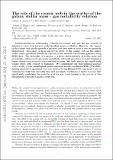The role of the cosmic web in the scatter of the galaxy stellar mass - gas metallicity relation
Date
14/03/2022Metadata
Show full item recordAbstract
The large-scale structure of the Universe can be understood in terms of features such as filaments, nodes and walls, which we collectively term the cosmic web. Galaxies evolve within the cosmic web, naturally raising the question of its impact on that process. There are two main mechanisms by which the cosmic web can influence galaxies: one is by modulating the growth of haloes, and the other is by regulating the gas ecosystem around galaxies. Disentangling the two is difficult, but key to deriving a holistic picture of galaxy formation and observational constraints on the growth of haloes. Here we report a detection of the effect of the cosmic web on the galaxy stellar mass–gas-phase metallicity relation of low-redshift star-forming galaxies using data from the Sloan Digital Sky Survey. The proximity of a galaxy to a node, independently of stellar mass and overdensity, influences its gas-phase metallicity, with galaxies closer to nodes displaying higher chemical enrichment than those farther away. We find a similar, but notably weaker, effect with respect to filaments. We find qualitative agreement in the cosmological hydrodynamical simulation IllustrisTNG (TNG300). Using IllustrisTNG, our results can be explained by both halo assembly bias and gas supply combining in nodes in a way that markedly modulates the metallicity of the gas, contributing to the scatter of this fundamental relation in galaxy evolution.
Citation
Donnan , C T , Tojeiro , R & Kraljic , K 2022 , ' The role of the cosmic web in the scatter of the galaxy stellar mass - gas metallicity relation ' , Nature Astronomy , vol. Advance Article . https://doi.org/10.1038/s41550-022-01619-w
Publication
Nature Astronomy
Status
Peer reviewed
ISSN
2397-3366Type
Journal article
Description
Funding for the Sloan Digital Sky Survey IV has been provided by the Alfred P. Sloan Foundation, the U.S. Department of Energy Office of Science, and the Participating Institutions.Collections
Items in the St Andrews Research Repository are protected by copyright, with all rights reserved, unless otherwise indicated.

